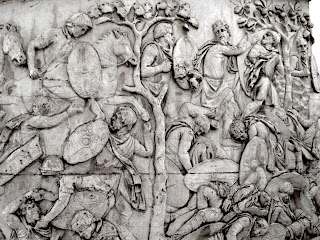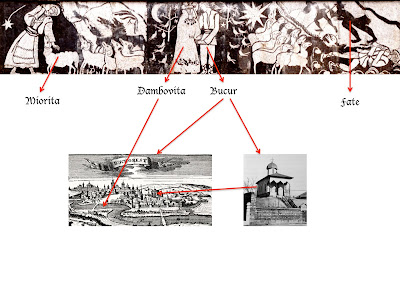19th century

During the 19th century, Kiselyov took particular care of the city: he acted against the plague and cholera epidemics of 1829 and 1831, instituted a "city beautifying commission" (first time the IMAGE comes in) comprising physicians and architects, paved many central streets with cobblestone (instead of wooden planks), drained the swamps formed around the Dâmboviţa and built public fountains, settled the previously-fluctuating borders of the city (it now measured ca.19 km in perimeter and was guarded by patrols and barriers), carved out Calea Dorobanţilor and Şoseaua Kiseleff (major north-south routes), mapped the city and counted its population, gave Bucharest a garrison for the newly-created Wallachian Army and improved its fire fighting service.
Covrigi
 People eat a lot of covrigi (pretzels) around here. It is like bread dough, but it is baked in a special shape, in a shape like angels crossing their hands or a shape like two people embracing one another. People like covrigi because it reminds them of the organic substance of life that is on the base of all this, even of this city, where blocks and concrete walls dominate the view.
People eat a lot of covrigi (pretzels) around here. It is like bread dough, but it is baked in a special shape, in a shape like angels crossing their hands or a shape like two people embracing one another. People like covrigi because it reminds them of the organic substance of life that is on the base of all this, even of this city, where blocks and concrete walls dominate the view.Moreover, if you eat your covrigi when it is still warm, you can feel the warmth of the sun reach right down into your stomach and lift you up. Have you noticed that people eating covrigi do not really touch ground with their feet?
you should try...
Circuit of mechandise (2)
The patients bring small "presents" to their doctor in the hospital, such as a glass of honey or a pack of cigarettes. The doctors sell these cigarettes to the salesman in the cigarette both in front of the hospital, where the next patients will buy cigarettes to bring a small "present" to their doctor.
Circuit of merchandise (1)
During election time, the political party prints their logo on lighters to hand them out to their potential electorat. When elections are over, the gypsies get the lighters, scratch of the logo and sell them on bus stops.
2010 - 1948 - 1989 - 2010
2010: The man who sells flowers on the street is counting his 1-Lei-Bills. He has built his house on a small piece of land. Now the land with the house on it is in the hands of a French lawyer, who bought the land from an Arab man, who bought the land from a Rumanian, who bought the land from an old French man in Paris, who lost this piece of land in 1948, and to whom it was returned after 1989. The man who sells flowers on the street knows nothing about all this.
Foundation Myths
 Once upon a time, there was a poor forest man who lived together with his daughter named Dambovita in a deep and big forest.
Once upon a time, there was a poor forest man who lived together with his daughter named Dambovita in a deep and big forest.One day, a prince from a faraway country lost himself in the forest. Meeting Dambovita, he asked her to find his way. The prince saw her beauty and asked her to marry him. Then Dambovita told him that she had already promised her hand to Bucur, a sherpherd who lived near the forest. As a thank you, the prince, who was no other than The Prince of the Mountains, offered the girl a little knife and a spinning top. If she spinned the top, any wish would come true.
After that meeting with the prince, the girl took the knife and the spinning top and showed them to Bucur. She thrusted the knife into a stone, and from that place a clear river sprang, and it was as clear as the tears of the girl. Dambovita named the river after her name, and they established a little village at the edge of the forest, on the banks of the river. Bucur named the setting after his name.
And thus, the little village, nowadays a big city, is called Bucuresti and the water that crosses it is called Dambovita.
Another version goes like that:


 Once upon a time when the sky was so close to the earth that tall men could touch it with their hands, which is true, for such things happened in days of old, the Dacians lived on the wooded plane in the land of milk and honey. They listened to the bees who told the stories of the cosmos and stars. The Dacians fought the Romans courageously, but they were violently crushed. One day, a Roman fell in love with a beautiful Dacian woman, and their descendants originated the Romanian people, who continue to this day to patiently accept destiny, not to dispute with death and to see history as a god-given myth. Their son, a shepherd called Bucur, married a river fairy named Dambovita and founded a church. Despite the warnings of his sheep Miorita, he was killed by fate. That is why even today the city which grew out of it is called Bucuresti and the river, which is as clear as the tears of a woman, is called Dambovita.
Once upon a time when the sky was so close to the earth that tall men could touch it with their hands, which is true, for such things happened in days of old, the Dacians lived on the wooded plane in the land of milk and honey. They listened to the bees who told the stories of the cosmos and stars. The Dacians fought the Romans courageously, but they were violently crushed. One day, a Roman fell in love with a beautiful Dacian woman, and their descendants originated the Romanian people, who continue to this day to patiently accept destiny, not to dispute with death and to see history as a god-given myth. Their son, a shepherd called Bucur, married a river fairy named Dambovita and founded a church. Despite the warnings of his sheep Miorita, he was killed by fate. That is why even today the city which grew out of it is called Bucuresti and the river, which is as clear as the tears of a woman, is called Dambovita.
Abonnieren
Posts (Atom)




